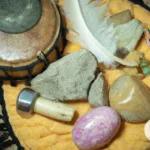Shamanism and Extraction Healing have gained significant popularity in recent years as people have become more interested in alternative methods of healing. Many individuals have turned to shamanic practices to address specific issues that modern medicine has failed to solve. Extraction healing is one such shamanic practice that has been used for centuries to remove energetic blockages from the body. A shaman’s role in this process is vital, as they use various tools and techniques to help clients recognize and release these blockages. This comprehensive guide will explore the role of a shaman in extraction healing, including understanding their responsibilities, preparing for the extraction process, tools and techniques used, working with clients, and aftercare.
What is Shamanism?
Shamanism is an ancient spiritual practice that involves connecting with the spirit world to seek guidance, healing, and wisdom. Shamans believe that everything is alive and has a spirit, and they work to maintain balance and harmony between the physical and spiritual realms. They use various techniques such as journeying, chanting, and rituals to access the spirit world and communicate with spirits. Extraction healing is one aspect of shamanism that involves removing energetic blockages that may be causing physical or emotional pain. Shamans believe that these blockages, known as intrusions, are caused by negative energy that has entered a person’s body, and they use their healing powers to extract these energies. To learn more about the basics of extraction healing and shamanism, you can check out /basics-of-extraction-healing-shamanism/.
What is Extraction Healing?
Extraction healing is a practice of removing spiritual blockages, intrusions, and other negative energies that are causing physical, emotional, or mental illness. It is one of the fundamental practices of shamanism and is considered an effective way to restore balance and well-being to the body, mind, and soul.
In shamanism, it is believed that illnesses are caused by spiritual imbalances and intrusions, and that these negative entities must be removed to restore health. Extraction healing is a spiritual process that involves the shaman identifying and extracting the negative energies or blockages that are causing the illness.
During an extraction healing session, the shaman will enter a trance state and communicate with the spirit world to identify the cause of the illness. They may use tools such as a drum or rattle and work with spirit guides to locate and extract the negative energies.
Extraction healing can be used to treat a variety of physical, emotional, and mental health issues, including chronic pain, anxiety, depression, and addiction. It is often used in combination with other shamanic practices, such as soul retrieval or power animal retrieval.
It is important to note that extraction healing should only be performed by a trained and experienced shaman. Like any spiritual practice, there are potential risks and benefits that should be carefully considered. Before undergoing extraction healing, it’s important to discuss the benefits and risks with a qualified shaman, and to follow up with integration and aftercare practices. An extraction healing session can be a powerful and transformative experience when approached with care and respect.
If you want to learn more about the causes and intrusions of extraction healing, follow the link to our article “Causes and Intrusions in Extraction Healing”.
The Role of a Shaman in Extraction Healing

The role of a shaman in extraction healing is to facilitate the removal of negative or harmful energy, entities or blockages that may be causing physical, emotional or spiritual distress in an individual. The shaman is a spiritual guide who uses their knowledge and connection to the spiritual realm to help clients release any unwanted energies, entities or attachments that may be impacting their overall well-being. During the extraction process, the shaman may use a variety of techniques, including the use of crystals, smudging, drumming, or chanting, to help identify and remove the source of the energy blockage. It is important to note that before any extraction work, the shaman will typically prepare themselves spiritually, emotionally, and mentally and ensure that the client is also prepared for the work. After an extraction healing, the shaman will provide integration and aftercare advice to ensure that the client continues to benefit from the healing process.
Understanding the Shaman’s Role
The role of a shaman in extraction healing is to act as an intermediary between the client and the spiritual realm. The shaman accesses this realm to identify the root cause of the client’s ailment and then extracts any negative energies or entities that may be present in the client’s body. The shaman also helps the client gain a new perspective on their illness or pain by explaining the spiritual significance of the experience.
In shamanic belief, illnesses and pain are caused by negative energies or entities that have become attached to the person’s soul. These negative energies can manifest as physical ailments like chronic pain, depression, anxiety, and addiction. The shaman’s role is to identify the type of energy causing the issue and extract it from the body.
Shamans believe that their role is to heal and help people connect with their spiritual selves during the extraction process. They help clients understand the root cause of their illness, emotions, and pain. By doing so, clients can release the negative energy from their body and mind.
Shamans assist clients by using their knowledge of Shamanism and their connection to the spiritual world. The shaman’s role is not only to perform the extraction process but also to guide the client through the healing journey. They may counsel clients on lifestyle changes and offer spiritual guidance on how to continue their healing process.
The shaman’s role in extraction healing is to identify the root cause of the client’s ailment, extract negative energy or entities, and provide spiritual guidance to the client. This is done by using their knowledge of shamanism and their connection to the spiritual realm. Understanding the shaman’s role is important for trusting the process and accepting the benefits of shamanism in extraction healing. For more information on the preparation of a shaman for extraction healing, please visit /prepare-extraction-healing/.
How the Shaman Prepares for the Extraction Process
How the Shaman Prepares for the Extraction Process
Before beginning the extraction process, the shaman must prepare themselves physically, mentally, and spiritually.
To prepare themselves spiritually, the shaman will often engage in prayer, meditation, or other rituals to connect with the spirit world and receive guidance. This helps the shaman to be in a state of heightened awareness and clarity during the extraction process.
To prepare themselves mentally, the shaman will often review the client’s history and discuss their intention for the extraction process. This helps the shaman to focus their attention and energy on the specific needs of the client.
To prepare themselves physically, the shaman will often gather the tools and materials needed for the extraction process. These may include crystals, feathers, stones, herbs, or other items that will be used during the process.
Additionally, the shaman may take certain precautions to protect themselves during the extraction process. This may include wearing protective clothing, such as gloves or face masks, or using smudging or other cleansing techniques to clear their energy field.
The shaman’s preparation for the extraction process is crucial to the success of the healing session. By preparing themselves on all levels, the shaman is able to create a safe and sacred space for the client’s healing to occur.
Internal link: If you want to know more about extraction healing, you can read our article about Shamanism and Extraction Healing.
Html list with tools:
- Crystals
- Feathers
- Stones
- Herbs
Html list with precautions:
- Wearing protective clothing
- Using smudging or other cleansing techniques
Tools and Techniques Used in Extraction Healing
Shamans use several tools and techniques to perform extraction healing. One of the most common techniques is using their hands to pull out the intrusive energies from the person’s body. During the process, the shaman may feel vibrations, heat, or cold sensations in their hands, indicating the presence of an energy blockage. Some shamans use tools such as feathers, crystals, or rattles to help them focus their energy and extract the intrusive energies.
Another tool used in extraction healing is smudging, which involves burning dried sage or other herbs to cleanse the person’s energy field. Smudging helps remove negative energy and creates a sacred space for the healing process.
In some cases, the shaman may use chants or singing to help move the negative energy out of the person’s body. The sound vibrations can help break up energy blockages and promote healing.
Internal html link: For more information on integration and aftercare after extraction healing, please see our article on Integration and Aftercare.
It’s important to note that while extraction healing can be effective, there are also some potential risks involved. Potential risks and benefits of extraction healing are covered in more detail in our article on the Benefits and Risks of Extraction Healing in Shamanism. It is recommended that individuals seek a qualified and experienced shaman for extraction healing to reduce any potential risks.
Working with Clients during Extraction Healing
During extraction healing, the shaman works closely with the client to ensure a successful outcome. The shaman’s role is to guide the client through the process and provide support and guidance as needed. The shaman understands that the client may be dealing with a range of emotions and may have questions about the process, so it’s important to establish a safe and comfortable environment for the client.
Active Listening is a crucial skill that the shaman uses during the healing process. The shaman listens attentively to the client’s words, body language, and energy. This allows the shaman to get a deeper understanding of what the client is experiencing and tailor their approach accordingly.
Intuition is another key aspect of working with clients during extraction healing. The shaman will use their intuition to sense any energy imbalances or blockages within the client’s energy field. This intuitive guidance is invaluable in guiding the shaman’s approach and ensuring that the client is receiving the most effective healing possible.
Clear Communication is also essential during the client-shaman interaction. The shaman will explain the extraction process to the client in a way that they can understand and answer any questions they may have. The shaman will also ask the client to share any feelings or sensations they experience during the process, allowing the shaman to adapt the healing as necessary.
In many cases, the shaman may use rituals and ceremonies to help create a safe and sacred space for the client. These may involve the use of crystals, incense, or other tools to help clear negative energy and promote healing.
Ultimately, the shaman’s role in working with clients during extraction healing is to guide them towards a state of balance and harmony. By working with the client closely, using active listening, intuition, clear communication, and ritual, the shaman can help the client to release negative energy and achieve a greater sense of well-being.










